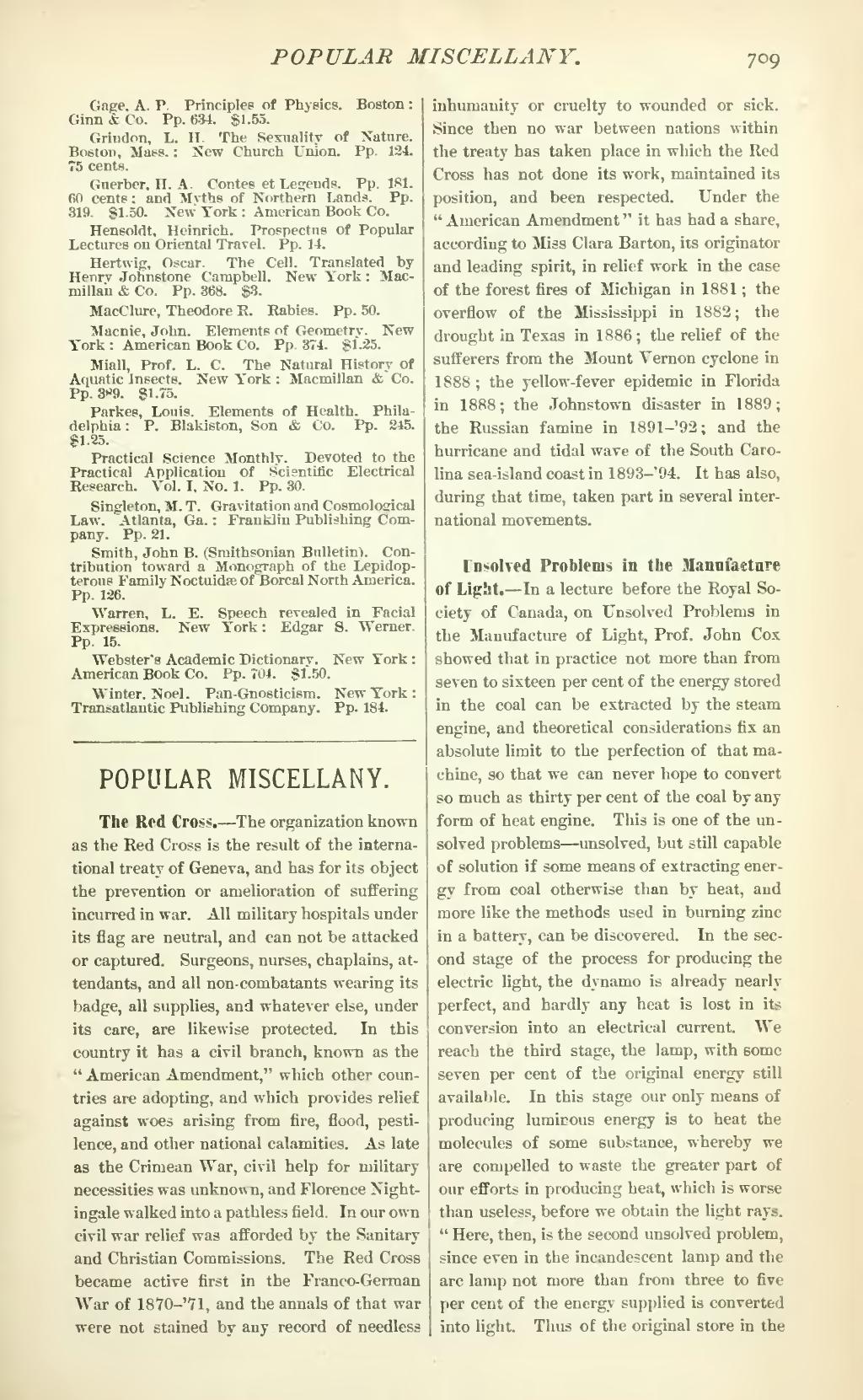Gage, A. P. Principles of Physics. Boston: Ginn & Co. Pp. 634. $1.55.
Grindon, L. H. The Sexuality of Nature. Boston, Mass.: New Church Union. Pp. 184. 75 cents.
Guerber, H. A. Contes et Legends. Pp. 181. GO cents; and Myths of Northern Lands. Pp. 319. $1.50. New York: American Book Co.
Hensoldt, Heinrich. Prospectus of Popular Lectures on Oriental Travel. Pp. 14.
Hertwig, Oscar. The Cell. Translated by Henry Johnstone Campbell. New York: Macmillan & Co. Pp. 368. $3.
MacClure, Theodore R. Babies. Pp. 50.
Macnie, John. Elements of Geometry. New York: American Book Co. Pp. 374. $1.25.
Miall, Prof. L. C. The Natural History of Aquatic Insects. New York: Macmillan & Co. Pp. 39. $1.75.
Parkes, Louis. Elements of Health. Philadelphia: P. Blakiston, Son & Co. Pp. 245. $1.25.
Practical Science Monthly. Devoted to the Practical Application of Scientific Electrical Research. Vol. I, No. 1. Pp. 30.
Singleton, M. T. Gravitation and Cosmological Law. Atlanta, Ga.: Franklin Publishing Company. Pp. 21.
Smith, John B. (Smithsonian Bulletin). Contribution toward a Monograph of the Lepidopterous Family Noctuidæ of Boreal North America. Pp. 126.
Warren, L. E. Speech revealed in Facial Expressions. New York: Edgar S. Werner. Pp. 15.
Webster's Academic Dictionary. New York: American Book Co. Pp. 704. $1.50.
Winter, Noel . Pan-Gnosticism. New York: Transatlantic Publishing Company. Pp. 184.
POPULAR MISCELLANY.
The Red Cross.—The organization known as the Red Cross is the result of the international treaty of Geneva, and has for its object the prevention or amelioration of suffering incurred in war. All military hospitals under its flag are neutral, and can not be attacked or captured. Surgeons, nurses, chaplains, attendants, and all non-combatants wearing its badge, all supplies, and whatever else, under its care, are likewise protected. In this country it has a civil branch, known as the "American Amendment," which other countries are adopting, and which provides relief against woes arising from fire, flood, pestilence, and other national calamities. As late as the Crimean War, civil help for military necessities was unknown, and Florence Nightingale walked into a pathless field. In our own civil war relief was afforded by the Sanitary and Christian Commissions. The Red Cross became active first in the Franco-German War of 1870-'71, and the annals of that war were not stained by any record of needless inhumanity or cruelty to wounded or sick. Since then no war between nations within the treaty has taken place in which the Red Cross has not done its work, maintained its position, and been respected. Under the "American Amendment" it has had a share, according to Miss Clara Barton, its originator and leading spirit, in relief work in the case of the forest fires of Michigan in 1881; the overflow of the Mississippi in 1882; the drought in Texas in 1886; the relief of the sufferers from the Mount Vernon cyclone in 1888; the yellow-fever epidemic in Florida in 1888; the Johnstown disaster in 1889; the Russian famine in 1891-92; and the hurricane and tidal wave of the South Carolina sea-island coast in 1893-'94. It has also, during that time, taken part in several international movements.
Unsolved Problems in the Manufacture of Light.—In a lecture before the Royal Society of Canada, on Unsolved Problems in the Manufacture of Light, Prof. John Cox showed that in practice not more than from seven to sixteen per cent of the energy stored in the coal can be extracted by the steam engine, and theoretical considerations fix an absolute limit to the perfection of that machine, so that we can never hope to convert so much as thirty per cent of the coal by any form of heat engine. This is one of the unsolved problems—unsolved, but still capable of solution if some means of extracting energy from coal otherwise than by heat, and more like the methods used in burning zinc in a battery, can be discovered. In the second stage of the process for producing the electric light, the dynamo is already nearly perfect, and hardly any heat is lost in its conversion into an electrical current. We reach the third stage, the lamp, with some seven per cent of the original energy still available. In this stage our only means of producing luminous energy is to heat the molecules of some substance, whereby we are compelled to waste the greater part of our efforts in producing heat, which is worse than useless, before we obtain the light rays. "Here, then, is the second unsolved problem, since even in the incandescent lamp and the arc lamp not more than from three to five per cent of the energy supplied is converted into light. Thus of the original store in the
